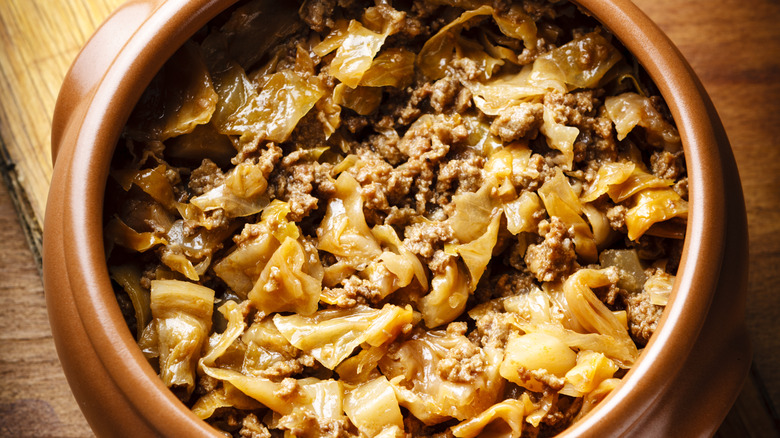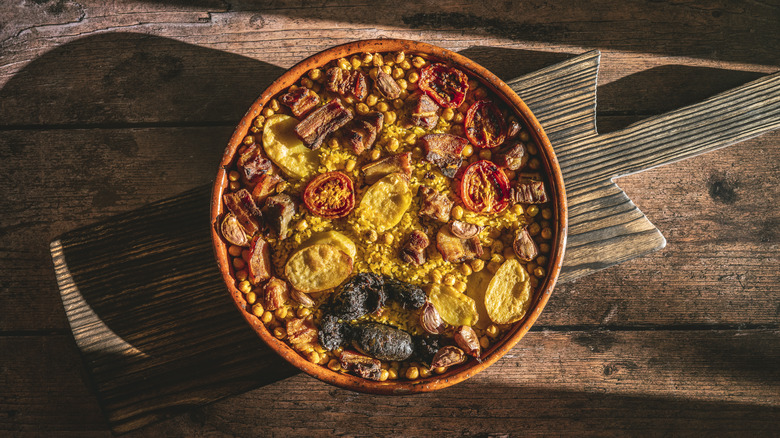Why Bobby Flay Prefers To Cook With Cazuelas
Bobby Flay has mastered just about every piece of cookware at his disposal. Since beginning his career in restaurants at 17 years old, he has amassed numerous tips concerning the grill, skillet, and even the toaster. Among the equipment Flay consistently uses is the cazuela: a Spanish earthenware pot that doubles as a serving dish.
Flay loves these shallow pots, largely because of how well they gently and slowly cook foods. Their ability to evenly distribute heat is largely attributed to the clay composition of cazuelas, which absorbs and then uniformly radiates warmth, contrasting with the direct heat conduction typical of metal cookware. Flay employs this earthenware for dishes like oven-baked salmon and roasted shrimp, as it maintains warmth more consistently than stainless steel.
Similar to a Moroccan tagine or a fajita skillet, the cazuela allows you to present food directly in it, making it an excellent choice for one-pot meals like this feast of seven fishes. Alternatively, it can serve as a stylish serving bowl for dishes that do not require cooking in earthenware.
Avoid sudden temperature changes with the cazuela
Cazuelas are durable, but they still need to be treated with care. Earthenware items can easily crack due to thermal shock, which occurs when clay and other heat-sensitive materials experience a rapid change in temperature. Specifically for cazuelas, you should primarily use them for low-heat recipes such as slow roasts and simmers, as they cannot withstand temperatures above 400 degrees Fahrenheit before being used a handful of times.
Thermal shock can occur not only when your clay pot is on the stove, but also when the cazuela comes into contact with a cool kitchen surface or sink. Therefore, it's important to let the pot cool down before serving or washing. When cleaning your cazuela, use a soft-bristled brush or sponge to gently remove any residue from its surface. Using any cleaning tool that's harsher could chip away at the cazuela's glaze and cause irreparable damage.
To help prevent thermal shocks, "season" your cazuela by submerging it in water overnight. This process hydrates the baked clay, preventing it from becoming too brittle. Theoretically, you should only need to season the pot once, but you might have to repeat this step if you do not use it regularly.
Other tricks for using and maintaining your cazuela
As you begin to use your cazuela to prepare your favorite Bobby Flay recipe, exercise some caution. Although baked clay pots have been reliable cookware since prehistoric times, they can easily get scratched if you drag them across a stovetop grill, or stir ingredients with sharp metal utensils. When not in use, ensure your cazuela is stored away from heat. Kitchen drawers are excellent for this, but any spot on your countertop away from the sun, stove, or sink should suffice to prevent your pot from becoming accidentally warm or wet.
Due to clay's ability to absorb and retain heat, cazuelas are ideal for low-and-slow cooking. Flay uses this earthenware to cook a variety of ingredients, such as mushrooms, shrimp, salmon, and squid. Clay pots are known to enhance the flavors in foods, even canned beans, so don't hesitate to try your favorite recipes in them.
While cazuelas can be easily found online, they are not as readily available at every brick-and-mortar supermarket or kitchenware store. If you're having trouble finding one, Flay suggests using any oven-safe container as an alternative. A Dutch oven or a cast iron skillet will work, but they might not have the same aesthetic appeal as a beautifully glazed cazuela.



